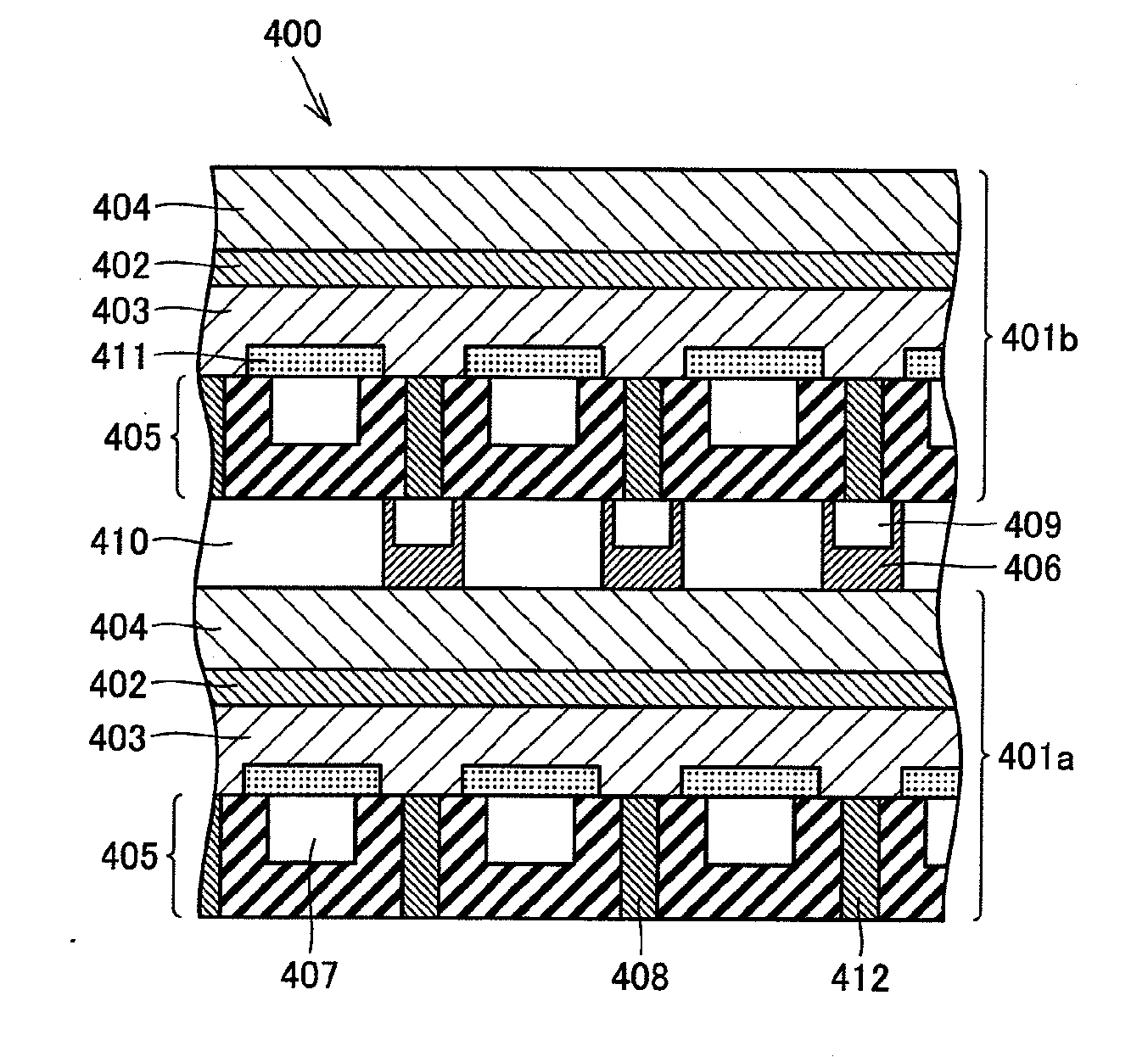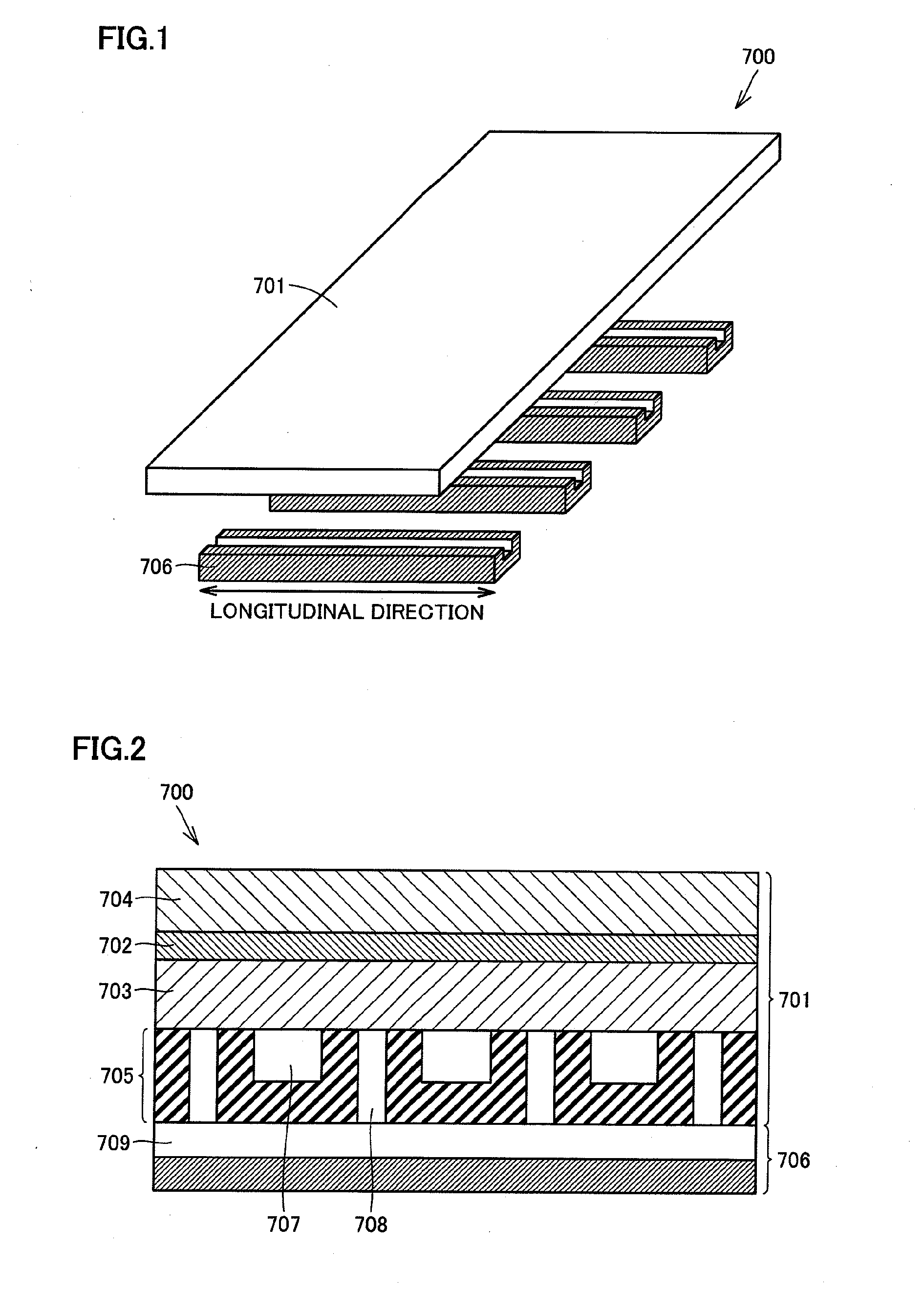Fuel cell and fuel cell stack
a fuel cell and stack technology, applied in the field of fuel cell and fuel cell stack, can solve the problems of increasing the size and weight of the fuel cell system, and achieve the effects of reducing weight, improving power generation efficiency, and efficiently exhausting reaction products
- Summary
- Abstract
- Description
- Claims
- Application Information
AI Technical Summary
Benefits of technology
Problems solved by technology
Method used
Image
Examples
first embodiment
[0030]FIG. 1 and FIG. 2 are an exploded perspective view and a cross sectional view, each of which schematically shows a preferred exemplary fuel cell of the present invention. A unit cell 701, which constitutes a fuel cell 700 shown in FIG. 1 and FIG. 2, includes an electrolyte membrane 702, an anode electrode 703 disposed on one surface of electrolyte membrane 702, a cathode electrode 704 disposed on the other surface of electrolyte membrane 702, and an anode collector layer 705 disposed in contact with an opposite surface of anode electrode 703 to the electrolyte membrane 702 side. Fuel cell 700 is constituted by unit cell 701 and one or more spacers 706 arranged on anode collector layer 705. The term “unit cell” herein refers to one unit constituting a fuel cell, and is defined as a structure including a membrane electrode assembly (MEA) and optionally other components combined with the membrane electrode assembly for the purpose of providing a power generation function or other...
second embodiment
[0033]FIG. 3 is a cross sectional view schematically showing a preferred exemplary fuel cell stack of the present invention. A fuel cell stack 100 shown in FIG. 3 includes a first unit cell 101a and a second unit cell 101b, each of which includes an electrolyte membrane 102, an anode electrode 103 disposed on one surface of electrolyte membrane 102, a cathode electrode 104 disposed on the other surface of electrolyte membrane 102, and an anode collector layer 105 disposed in contact with an opposite surface of anode electrode 103 to the electrolyte membrane 102 side. Fuel cell stack 100 is formed by arranging first unit cell 101a and second unit cell 101b with one or more spacers 106 interposed therebetween so that cathode electrode 104 of first unit cell 101a faces anode collector layer 105 of second unit cell 101b.
[0034]Anode collector layer 105 includes fuel flow paths 107 each of which is a space for transportation of fuel, and through holes 108 for exhausting a reaction produc...
third embodiment
[0077]FIG. 5 is a cross sectional view schematically showing another preferred exemplary fuel cell stack of the present invention. A fuel cell stack 300 shown in FIG. 5 has a configuration similar to that of the foregoing second embodiment, except that fuel permeation layers 311 are provided. The following describes the fuel permeation layer in detail.
[0078]
[0079]Fuel permeation layer 311 is a layer allowing the fuel to pass therethrough, has a diffusion resistance of the fuel in the thickness direction thereof, and has a function of restricting a permeation flux of the fuel. Further, fuel permeation layer 311 is not porous and has a function of blocking permeation of the gas in the thickness direction thereof. As shown in FIG. 5, fuel permeation layer 311 is formed between an anode collector layer 305 and an anode electrode 303 so as to cover an opening at the anode electrode 303 side of a fuel flow path 307.
[0080]Fuel permeation layer 311 thus provided with such a configuration al...
PUM
 Login to View More
Login to View More Abstract
Description
Claims
Application Information
 Login to View More
Login to View More - R&D
- Intellectual Property
- Life Sciences
- Materials
- Tech Scout
- Unparalleled Data Quality
- Higher Quality Content
- 60% Fewer Hallucinations
Browse by: Latest US Patents, China's latest patents, Technical Efficacy Thesaurus, Application Domain, Technology Topic, Popular Technical Reports.
© 2025 PatSnap. All rights reserved.Legal|Privacy policy|Modern Slavery Act Transparency Statement|Sitemap|About US| Contact US: help@patsnap.com



